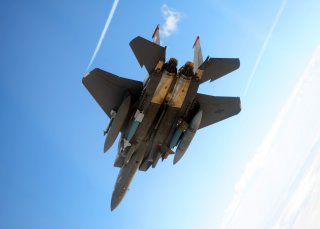The Russian Military Wishes It Had These 5 U.S. Weapons
The Russian military remains extraordinarily dangerous. However, it still struggles with the legacy of the Cold War.
Here's What You Need to Remember: The Russian military still lacks the intelligence, communications, and coordination capabilities that characterize the American way of fighting war. While Russian forces have fought effectively in Georgia, Ukraine and Syria, additional drones, lightweight communications equipment, satellite guidance, and high-speed computers could make the military far more capable.
During the Cold War, the Soviet Union and the United States struggled to match each other’s best weapons. The MiG-25 informed the F-15; the Tu-95 “Backfire” resembled the B-52; submarines and tanks were designed with their competitors firmly in mind.
As the Cold War ticked to its end, the USSR lost the ability to compete with the United States in many key areas. The collapse of the Soviet military-industrial complex after the fall of the Soviet Union only exacerbated this problem. Today, even though the Russian military remains formidable, it continues to have key deficiencies relative to the United States. Here are five areas in which Russia would like to have the capabilities that the United States now enjoys.
Fifth-Generation Fighters
Five years ago, the Sukhoi PAK FA was expected to help Russia close the gap that had emerged between U.S. and Russian frontline fighter aircraft. Today, the program is struggling, with technical and economic factors leading to a dramatic reduction in projected orders. The United States, on the other hand, has successfully integrated the F-22 Raptor into frontline service.
While Russia continues to build and operate formidable fighters, none of them can compare to the Raptor. Until the PAK FA or a successor aircraft come into service, the United States will have a decided advantage in the air superiority game.
Precision Guided Munitions
Although Russia has begun to use precision-guided munitions more extensively in Syria than it did in either Georgia or Ukraine, it still lags behind the United States in deployment of these kinds of weapons. Part of the reason is doctrinal; the Russian military tends to be less sensitive to collateral damage than the U.S. military. But another part is that Russia still lacks the extensive stockpiles of PGMs that the United States has built over the decades. Moreover, Russian aircraft usually lack the sensor pods that characterize most Western aircraft in air-to-ground missions. This makes a Russian air campaign a much different (and in some ways less effective) endeavor than its Western counterpart.
Intelligence-Surveillance-Reconnaissance Complex
Of course, it doesn’t matter if you can hit something with precision if you don’t know where to strike. In the waning years of the Cold War, military thinkers in the Soviet Union came to understand that the ability to integrate long-range strike and information technology would characterize dominance in the next military era. They also understood that the Soviet Union lacked the national innovation system necessary to compete with the United States on advanced computer and communications technologies.
Some of those factors have changed, and some have not. The Russian military still lacks the intelligence, communications, and coordination capabilities that characterize the American way of fighting war. While Russian forces have fought effectively in Georgia, Ukraine and Syria, additional drones, lightweight communications equipment, satellite guidance, and high-speed computers could make the military far more capable.
Amphibious Warfare
In 2010, Russia contracted with France to acquire four Mistral-class amphibious-assault ships. France would build the first two, and assist Russia with the construction of the second pair. The ships would fill a glaring hole in Russian amphibious-warfare capabilities, which had lain fallow since the end of the Cold War.
But it was not to be. The Russian seizure of Crimea and invasion of Ukraine led France to cancel the transfer, leaving Russia without any modern amphibious warships. Had the Russian Navy acquired the Mistrals, they might be off the Syrian coast right now. Instead, the Navy depends on older vessels, while the shipbuilding industry struggles to assemble large, modern ships.
Professional Force
Russia continues to struggle with its outmoded conscript system. This system enlists a remarkably low percentage of the eligible Russian population (some estimates suggest as low as 11 percent of males age 19 to 27), and military authorities generally consider the conscripts to be of particularly low quality. In essence, most young men with good health, education, and any prospects manage to avoid the draft. In effect, this renders a huge swath of the Russian Army useless for any practical purpose.
Russia has developed a series of plans to professionalize its army, but it continues to run up against cultural problems (a commitment to conscription runs deep within the army, and even the Eastern European states that have joined NATO have struggled to move forward), and financial constraints. An all-volunteer army with a professional corps of noncommissioned officers would do wonders for enhancing Russia’s military effectiveness.
The Russian military remains extraordinarily dangerous. However, it still struggles with the legacy of the Cold War. The contraction of the Russian economy and the crash in the price of oil haven’t helped, either. Nevertheless, there’s every reason to believe that the Russians understand their military deficiencies, and are working hard to remedy the problems.
Robert Farley, a frequent contributor to the National Interest, is author of The Battleship Book. He serves as a senior lecturer at the Patterson School of Diplomacy and International Commerce at the University of Kentucky. His work includes military doctrine, national security and maritime affairs. He blogs at Lawyers, Guns and Money, Information Dissemination and the Diplomat.
This first appeared in 2016 and is being republished due to reader interest.
Image: Flickr.

